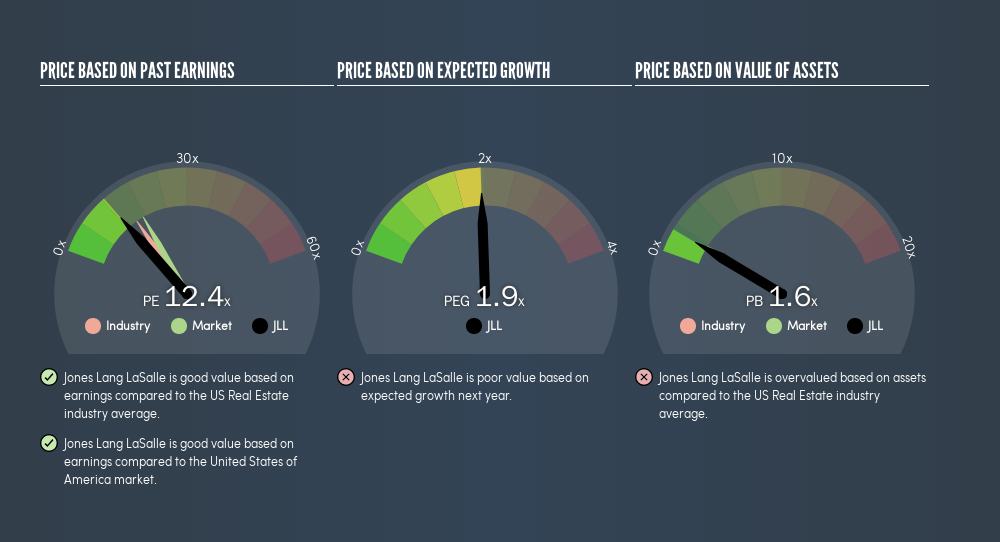- United States
- /
- Real Estate
- /
- NYSE:JLL
Does Jones Lang LaSalle Incorporated (NYSE:JLL) Have A Good P/E Ratio?

Want to participate in a short research study? Help shape the future of investing tools and you could win a $250 gift card!
Today, we'll introduce the concept of the P/E ratio for those who are learning about investing. To keep it practical, we'll show how Jones Lang LaSalle Incorporated's (NYSE:JLL) P/E ratio could help you assess the value on offer. Jones Lang LaSalle has a P/E ratio of 12.45, based on the last twelve months. In other words, at today's prices, investors are paying $12.45 for every $1 in prior year profit.
Check out our latest analysis for Jones Lang LaSalle
How Do I Calculate A Price To Earnings Ratio?
The formula for price to earnings is:
Price to Earnings Ratio = Share Price ÷ Earnings per Share (EPS)
Or for Jones Lang LaSalle:
P/E of 12.45 = $127.02 ÷ $10.21 (Based on the trailing twelve months to March 2019.)
Is A High P/E Ratio Good?
A higher P/E ratio implies that investors pay a higher price for the earning power of the business. That isn't a good or a bad thing on its own, but a high P/E means that buyers have a higher opinion of the business's prospects, relative to stocks with a lower P/E.
How Growth Rates Impact P/E Ratios
Probably the most important factor in determining what P/E a company trades on is the earnings growth. When earnings grow, the 'E' increases, over time. And in that case, the P/E ratio itself will drop rather quickly. A lower P/E should indicate the stock is cheap relative to others -- and that may attract buyers.
Jones Lang LaSalle increased earnings per share by a whopping 50% last year. And its annual EPS growth rate over 5 years is 11%. So we'd generally expect it to have a relatively high P/E ratio.
How Does Jones Lang LaSalle's P/E Ratio Compare To Its Peers?
We can get an indication of market expectations by looking at the P/E ratio. We can see in the image below that the average P/E (14.5) for companies in the real estate industry is higher than Jones Lang LaSalle's P/E.

Jones Lang LaSalle's P/E tells us that market participants think it will not fare as well as its peers in the same industry. Since the market seems unimpressed with Jones Lang LaSalle, it's quite possible it could surprise on the upside. If you consider the stock interesting, further research is recommended. For example, I often monitor director buying and selling.
A Limitation: P/E Ratios Ignore Debt and Cash In The Bank
Don't forget that the P/E ratio considers market capitalization. That means it doesn't take debt or cash into account. Theoretically, a business can improve its earnings (and produce a lower P/E in the future) by investing in growth. That means taking on debt (or spending its cash).
Such expenditure might be good or bad, in the long term, but the point here is that the balance sheet is not reflected by this ratio.
How Does Jones Lang LaSalle's Debt Impact Its P/E Ratio?
Jones Lang LaSalle's net debt equates to 35% of its market capitalization. While it's worth keeping this in mind, it isn't a worry.
The Verdict On Jones Lang LaSalle's P/E Ratio
Jones Lang LaSalle has a P/E of 12.4. That's below the average in the US market, which is 17.2. The company hasn't stretched its balance sheet, and earnings growth was good last year. The low P/E ratio suggests current market expectations are muted, implying these levels of growth will not continue. Because analysts are predicting more growth in the future, one might have expected to see a higher P/E ratio. You can taker closer look at the fundamentals, here.
Investors should be looking to buy stocks that the market is wrong about. If it is underestimating a company, investors can make money by buying and holding the shares until the market corrects itself. So this free visualization of the analyst consensus on future earnings could help you make the right decision about whether to buy, sell, or hold.
Of course you might be able to find a better stock than Jones Lang LaSalle. So you may wish to see this free collection of other companies that have grown earnings strongly.
We aim to bring you long-term focused research analysis driven by fundamental data. Note that our analysis may not factor in the latest price-sensitive company announcements or qualitative material.
If you spot an error that warrants correction, please contact the editor at editorial-team@simplywallst.com. This article by Simply Wall St is general in nature. It does not constitute a recommendation to buy or sell any stock, and does not take account of your objectives, or your financial situation. Simply Wall St has no position in the stocks mentioned. Thank you for reading.
About NYSE:JLL
Jones Lang LaSalle
Operates as a commercial real estate and investment management company.
Flawless balance sheet and good value.
Similar Companies
Market Insights
Community Narratives





